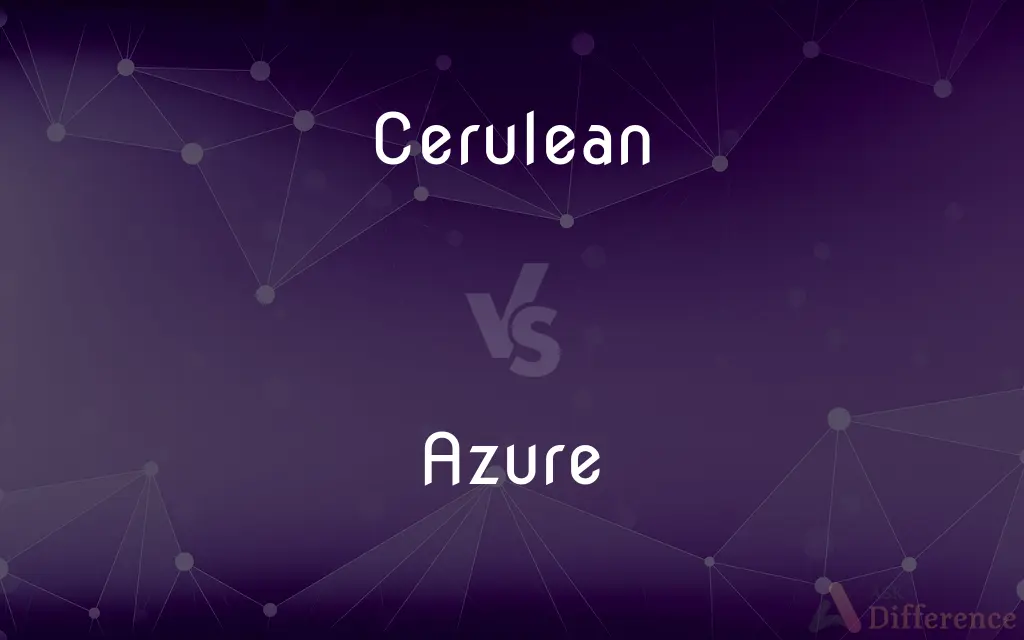Cerulean vs. Azure — What's the Difference?
By Fiza Rafique & Urooj Arif — Updated on April 3, 2024
Cerulean and azure are shades of blue; cerulean is a deep sky blue, while azure is a bright, cyan-blue. Both capture different moods of the sky and sea.

Difference Between Cerulean and Azure
Table of Contents
ADVERTISEMENT
Key Differences
Cerulean is a shade of blue that evokes the color of clear skies. It's often described as a deep sky blue, leaning slightly towards turquoise but maintaining a strong blue essence. This color can bring to mind the serene, tranquil quality of a summer sky. On the other hand, azure is a bright, vivid shade of blue that is sometimes compared to the color of the tropical sea. It is more cyan-leaning than cerulean, often used to represent vibrant, clear skies and seas. Azure's vibrancy makes it a color associated with clarity and the vastness of the ocean.
While cerulean offers a calming, deep sky blue that suggests depth and stability, azure presents a brighter, more radiant hue that symbolizes high energy and expansiveness. The difference in their tones means they evoke different feelings; cerulean is more reflective and soothing, whereas azure is lively and invigorating. This makes cerulean a popular choice for peaceful, tranquil settings, while azure is often used to capture attention and symbolize vitality.
Cerulean's depth allows it to be used in a variety of contexts, from fashion to interior design, where it adds a layer of sophistication and calm. It is versatile, fitting both modern and classic styles. Azure, with its striking brightness, is frequently used in design and art to create a sense of openness and infinity. It is particularly effective in spaces and creations intended to energize and inspire.
In terms of color theory, cerulean is seen as more grounded, offering a sense of security and tranquility, which makes it excellent for spaces meant to soothe and calm. Azure, embodying the vastness of the sky and sea, encourages open-mindedness and creativity, making it suitable for stimulating environments. These distinct qualities mean that while both colors share a base in blue, their applications and the moods they create are notably different.
Cerulean and azure are both captivating shades of blue, each with its unique character. Cerulean brings the depth and calm of a clear sky, ideal for serene, reflective spaces. Azure, bright and vivid, captures the essence of the expansive sea and sky, perfect for creating a sense of vitality and inspiration.
ADVERTISEMENT
Comparison Chart
Hue
Deep sky blue leaning slightly towards turquoise.
Bright cyan-leaning blue.
Mood Evoked
Serenity, tranquility, and calm.
Vitality, clarity, and expansiveness.
Symbolism
Depth, stability, and reflection.
Energy, openness, and inspiration.
Common Uses
Fashion, interior design, art.
Design, art, digital media.
Color Theory
Grounded, secure, soothing.
Stimulating, creative, expansive.
Compare with Definitions
Cerulean
Associated with serenity and depth.
His eyes were a striking shade of cerulean.
Azure
Often associated with energy and creativity.
The azure highlights in the logo added a vibrant touch.
Cerulean
Versatile in design and fashion.
Cerulean accents bring a touch of calm to the decor.
Azure
Symbolizes vitality and expansiveness.
Her painting captured the azure vastness of the ocean.
Cerulean
A calming, reflective shade of blue.
The room's cerulean walls created a tranquil atmosphere.
Azure
A bright, cyan-leaning shade of blue.
The azure sky above was clear and inviting.
Cerulean
Symbolizes stability and tranquility.
The cerulean sea beneath them was a vast expanse of peace.
Azure
Used to represent clarity and openness.
The azure waters reflected the sun's brilliance.
Cerulean
A deep sky blue color.
The cerulean dress she wore perfectly captured the summer sky.
Azure
Captures the essence of the sea and sky.
The island was surrounded by an endless azure expanse.
Cerulean
Cerulean (), also spelled caerulean, is a shade of blue ranging between azure and a darker sky blue. The first recorded use of cerulean as a colour name in English was in 1590.
Azure
A bright blue, as of a clear sky.
Cerulean
Azure; sky-blue.
Azure
(Heraldry) The color blue.
Cerulean
A greenish-blue color.
Azure
The blue sky.
Cerulean
(countable) Any of various lycaenid butterflies of the genus Jamides.
Azure
The clear blue colour of the sky; also, a pigment or dye of this colour.
Cerulean
Sky-blue.
Azure
(tincture) A blue colour on a coat of arms, represented in engraving by horizontal parallel lines.
Cerulean
Sky-colored; blue; azure.
Blue, blue, as if that sky let fall
A flower from its cerulean wall.
Azure
(poetic) The unclouded sky; the blue vault above.
Cerulean
A light shade of blue
Azure
Any of various widely distributed lycaenid butterflies of the genus Celastrina.
Cerulean
Of a deep somewhat purplish blue color similar to that of a clear October sky;
October's bright blue weather
Azure
Any of various Australasian lycaenid butterflies of the genus Ogyris.
Azure
Lapis lazuli.
Azure
Sky blue; resembling the clear blue colour of the unclouded sky
Azure
Cloudless
Azure
(tincture) In blazon, of the colour blue.
Azure
(transitive) To colour blue.
Azure
Sky-blue; resembling the clear blue color of the unclouded sky; cerulean; also, cloudless.
Azure
The lapis lazuli.
Azure
The clear blue color of the sky; also, a pigment or dye of this color.
Azure
The blue vault above; the unclouded sky.
Not like those stepsOn heaven's azure.
Azure
A blue color, represented in engraving by horizontal parallel lines.
Azure
To color blue.
Azure
A light shade of blue
Azure
Color azure;
Morning azured the village
Azure
Of a deep somewhat purplish blue color similar to that of a clear October sky;
October's bright blue weather
Common Curiosities
Can cerulean and azure be used together?
Absolutely, combining cerulean and azure can create a dynamic and visually appealing palette that plays on the different shades of blue.
Which color is closer to the color of the sky?
Both can represent the sky, with cerulean depicting the deep, tranquil sky and azure reflecting the bright, clear sky.
How do emotions associated with cerulean and azure differ?
Cerulean evokes feelings of calmness and stability, while azure is more likely to inspire vitality and expansiveness.
How do these colors affect mood in interior design?
Cerulean can create a serene and calming space, while azure can make a space feel more open and energizing.
Are there any cultural significances to cerulean and azure?
Cultural significances can vary, but both colors are often associated with positive qualities like calmness, clarity, and creativity across cultures.
What is the main difference between cerulean and azure?
Cerulean is a deeper, more subdued sky blue, while azure is a brighter, cyan-leaning shade of blue.
Which color would be more stimulating in a workspace?
Azure, with its brightness and association with creativity, would be more stimulating in a workspace.
Are cerulean and azure used differently in design?
Yes, cerulean is often used for its calming effect and versatility, while azure is chosen for its vibrancy and to evoke openness and creativity.
Is one color more popular than the other?
Popularity varies by context and trend, with cerulean often favored for its timeless tranquility and azure for its lively appeal.
What is the best way to pair these colors in fashion?
Pairing cerulean and azure with neutral tones can highlight their beauty without overwhelming, creating elegant and vibrant looks.
Share Your Discovery

Previous Comparison
Mater vs. Pater
Next Comparison
Sorcery vs. WitchcraftAuthor Spotlight
Written by
Fiza RafiqueFiza Rafique is a skilled content writer at AskDifference.com, where she meticulously refines and enhances written pieces. Drawing from her vast editorial expertise, Fiza ensures clarity, accuracy, and precision in every article. Passionate about language, she continually seeks to elevate the quality of content for readers worldwide.
Co-written by
Urooj ArifUrooj is a skilled content writer at Ask Difference, known for her exceptional ability to simplify complex topics into engaging and informative content. With a passion for research and a flair for clear, concise writing, she consistently delivers articles that resonate with our diverse audience.














































